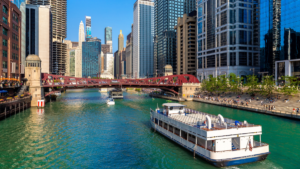Risky Business
10/24/2018
By Maura Keller
Predicting the future is like forecasting the weather. You think you know what’s going to happen—then it doesn’t. There has been a great deal written in the past few years concerning the legal liability of meetings and events, usually in terms of a weather-related crisis or the likelihood of personal injury. So to what extent do meeting and event planners have to pay attention to crisis planning, prevention and management? Quite a bit, say the experts.
In the world of meeting planning, there are a myriad of disruptive challenges that occur. While most of these disruptions are unpredictable and uncontrollable, evaluating and managing the inherent risk of offsite meetings and events is paramount in an age of unpredictability.
“Every meeting is unique so planning should begin with a risk assessment, the results of which will determine what security and other risks need to be managed,” says Jack Plaxe, a career security crisis, and risk management professional with nearly 30 years of experience as a consultant and corporate security director. He also is founder and managing director at Security Consulting Alliance. “If you don’t have the resources in-house to conduct an assessment, an outside security consultant may be able to assist.”
Meghan Palm, CMP, owner and global meetings and events manager at Meetings and Events Group, says it is vital that meeting planners know who is in charge in any given situation.
“As meetings managers, we are used to being in charge and having all the answers, but in emergency situations, it is our role to keep our constituents calm, safe and well informed,” Palm says. “For hotel security concerns, it may be the hotel general manager or the director of security making the final calls or if there is a natural disaster, it may be the local government offices making decisions. All entities need to work together as a centralized team and have a clear understanding of the chain of communication to cut down on delays and confusion.”
According to the Incentive Research Foundation, a study that the foundation conducted in 2016 to determine what was disrupting events and how planners were coping found that almost 60 percent of planners had experienced a disruption of at least one event that affected the event’s overall outcome or success. The report indicated that the two most frequently occurring disruptions are weather-related events and vendor failures.
And since 9/11, terrorism has become a reality at home and abroad. That’s why the safety of attendees is paramount and key in choosing a location for a meeting or event.
“Where will the meeting be held? If on a corporate campus, company security staff can be enlisted to secure the venue, patrol the area and control access,” Plaxe says. “If off-site at a hotel or convention center, an assessment of the security arrangements should be conducted in advance of the meeting to ensure that they meet company requirements.”
And whether in another country or in the US, it is important to remind attendees of simple ways to be safe and remain aware of their surroundings. Some helpful tips include: know where the local police station, hospital or hotel are located, have a cell phone charged at all times and avoid high risk areas. If overseas, a more in-depth country risk assessment is in order that considers travel risk, security risk, health risk and political risk.
BEING PREPARED
There are a number of ways that planners can prepare for disruptions—including tighter contractual language, more backup resources, better contingency planning, establishing more guidelines and extending planning cycles. But sometimes the preparation calls for more drastic action.
Having clear attrition policies, force majeure language, insurance coverages, data security, supplier responsibility and sponsor management contact chains identified, contracted and incorporated as part of the program are “must haves” when it comes to crisis management for meetings.
“Perhaps the most important issue that meeting planners should focus on is fire and life safety,” Plaxe says. “Everyone should be told where the nearest primary and secondary emergency exits are located, along with assembly areas for each. Planners should have a way to account for all meeting attendees and contact anyone who does not show up at a designated assembly point in the aftermath of an emergency.”
And while there may be hundreds of situations that are disruptive, there are really only a few paths to manage the consequence of any event. One key way is by having a destination plan identifying the names and contacts of hospitals, clinics, emergency services, supplier emergency leadership and contacts. Also the creation of a guest “status check-in” process during a disruption event creates the ability to take a census of status and location of each guest.
Having a ‘Plan B’ ready for all major programmatic elements, working hand-in-hand with the hotel and venue to consider alternative options, and knowing how to create VIP experiences out of delays or frustrations is the best way to turn around those pesky disruptive situations. ON A LARGER SCALE Since no meeting planner has a crystal ball, they should focus on having tools in place to handle the consequences of a possible event. These may include an internal handbook of emergency resources and strategies, understanding of a client’s management hierarchy for decision making for financial, operational and PR decisions so the planner knows who to reach out to for what, and a communications tool to dialogue with guests for status and locations via their smart phones in real time.
Natural disasters, power outages, fire hazards and active shooters should all be planned for. However, if meals are being served at a meeting, it’s important to prepare for food borne illness and life-threatening allergic reactions as well.
And, over the years, mass shootings, terrorism and bomb scares have taken a significant toll upon our society and instilled fear in many attendees when gathering at large venues–whether it is for a movie, a conference, a sporting event or a concert.
“Setting better policy, national standards and allocating funds that will provide safeguards, better security and better preparedness for the industry overall is critical,” says Tim Heffernan, chief development officer at T3 Expo. “We fully support the idea of enhancing safety and security measures, but this will take money, resources and an active dialogue from many parties, including Congress.”
As Heffernan explains, T3 Expo, International Association of Exhibitions and Events, and its members have all been in discussions focused on increasing the physical security at events. The groups have been aligned with the Department of Homeland Security (DHS) to develop the Exhibitions and Meetings Safety and Security Initiative (EMSSI), which aligns convention center security guidelines with federal programs and the Department of Homeland Security/ Safety Act Office.
“This initiative will produce a comprehensive security benchmark helping create safer and more secure large-scale events,” Heffernan says. “We need to step up venue security to provide immediate resources and funding. We need to look at investments in canine units for bomb threats, additional security around the perimeter and inside the events, and implementing metal detectors for other possible threats. Consumers are used to having bags scanned, we don’t see this as any inconvenience, but as an assurance that our attendees are safe.”











